The following agency compensation survey and commentary appeared in the March 2003 Middleton Letter, which was previously published by the late Carol Hammes, and is now produced by Marsh, Berry & Co. Inc. in Hammes’ honor.
The survey presents the average answers provided by the hundreds of agencies participating in the survey, divided into rural (marketing areas with populations under 10,000) and suburban/urban categories. Because these averages have not been weighted by size of agency or location in the country, the information can be misleading if taken out of context or without adjustment for circumstances that can be particular to certain insurance agency operations. When comparing an agency’s compensation program to the national results, the results should be adapted to reflect the agency’s marketplace and orientation.
The Department of Labor salary data indicates that a number of states have average per capita incomes that are significantly higher or lower than the norm. The following table can be used to help adjust the national results of the survey to fit particular marketing areas. States not shown on the chart have per capita incomes within five percent on either side of the median level.
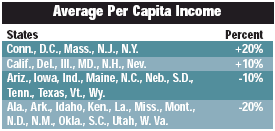
General agency compensation
The average rural agency responding to the survey had $839,916 in total revenues in 2002 generated by 9.4 employees, including the owners. The urban agencies had an average of $2,318,053 in revenues in 2002 with a head count of 20.4. Overall, the agencies responding to the survey had revenues 40 percent greater than those agencies that participated two years ago. Revenues per employee were $89,353 in the rural agencies, up 11.5 percent from the 2000 level of $80,166, which had increased 11.1 percent from the 1998 level of $72,061. In the metropolitan, firms the revenue per employee figure went from $99,646 to $113,630 over the past two years, an increase of 14 percent, while they had posted only a four percent increase from 1998 to 2000. As mentioned in the Dec. 2002 Middleton Letter, regardless of size the better insurance agencies in the country are now achieving revenues per employee in excess of $110,000. There were 1.7 agency principals in the rural firms and 2.5 in the urban firms. Between 23 percent and 29 percent of the total employees in the survey agencies were involved primarily in sales activities, 12 percent to 18 percent were in management and 58 percent of the total employee group were mainly handling services and support functions.
The average reported increase in agency salaries was 3.4 percent in the rural firms and 4.4 percent in the urban agencies. This is lower than the increases reported in previous years, especially in the rural agencies. Over half of the firms said their percentage increase was the same as it had been the prior year, while one-fourth reported paying a higher increase this year than last.
The rural firms reported a pretax profit of 11.2 percent with the owners taking out another 24.5 percent in W-2 income. This puts the ownership return ratio at 35.7 percent comparable with the 35.4 percent reported in the last compensation survey. Urban owners had an average profit margin of 11.6 percent, compensation of 21.2
percent and a return ratio of 32.8 percent, down from the 34.0 percent reported in 2000.
Non-owner producers were paid 14.4 percent of total revenues in rural agencies and 13.4 percent of revenues in suburban/urban firms. Non-owner managers and staff received 21.7 percent and 20.2 percent of total revenues. As the following chart shows, there has not been much change in payroll percentages or profit margins over the past several years.

More than 60 percent of the agencies have an incentive bonus plan that rewards employees based upon some definition of agency results. While agency profitability is the most popular criteria for determining the incentive payments in urban firms, revenue growth and increased productivity are used in rural agencies. Splitting contingent income continues to be used in the suburban/urban firms. Other methods mentioned include new business sales, policy count growth, production goals, retention and employee evaluations.
Most agencies (72 percent rural and 93 percent suburban/urban) provide group health insurance for their employees with 90 percent of the employee’s coverage paid by the agency and 34 percent to 26 percent of the dependent’s premiums also covered. Among the rural agencies, 83 percent have some sort of retirement plan (up from 70 percent two years ago) with 42 percent of them using a 401(k) plan and 15 percent having a qualified profit sharing plan. IRA/Keogh/ SEP remain popular with 22 percent of the rural firms using that form of retirement plan. In contrast, 94 percent of the urban agencies have retirement programs with the 401(k) option having been chosen by 55 percent. Another 19 percent of the metropolitan firms have profit sharing plans and 13 percent have IRA/Keogh/SEP programs available for their employees.
Service staff compensation
The charts below present the average salary ranges for the major service positions in insurance agencies as they entered the 2003 year. Rural and urban agencies reported increases ranging from 11 percent to 23 percent at the starting salary range for some of the commercial lines positions. The commercial lines service representative with over seven years experience salary range increased substantially indicating the level of professionalism that this position now demands. The size of the agencies responding to this survey increased from those in the previous results, and these salary ranges may be a reflection of that fact. Note, however, that the size of any agency usually does not have much of a bearing on the salaries and benefits paid since the smaller firms must compete for talent with the larger ones in a designated marketing area.
These are the national averages which must be adjusted for regional variations. For example, if the agency is located in a metropolitan area in Illinois, you should take the +10 percent factor shown on the prior page and apply this to the national salary range. For an experienced commercial CSR, the computations to adjust the salary range would be: 1.10 x $38,929 – $46,342 = $42,822 – $50,976.
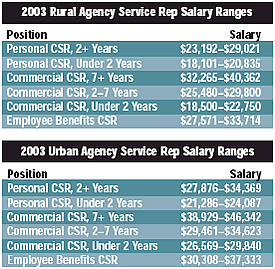
In many agencies the personal lines CSRs also receive additional compensation for selling new business and expanding existing accounts. Fifty percent of the rural firms have some type of incentive. This ranges from an average of $15 per policy to 36 percent of the first year commissions and five percent on renewal. More than half of the urban agencies (57 percent) have such programs, paying either an average of $18 per policy or 34 percent of new commissions and two percent on renewal. Most of these amounts have not changed from two years ago.
Sales compensation
Producers in rural agencies have more correlation between performance and compensation than they did previously as 35 percent of them now receive straight commissions or a salary as a draw against commissions versus 30 percent two years ago. Forty-seven percent are receiving salary plus commissions or a production bonus whereas only 18 percent are now on salary only, a significant decrease from the 32 percent who received a salary in 2000.
In suburban/urban agencies 55 percent of the producers are receiving straight commissions or a salary as a draw against commissions, while 34 percent receive a salary plus commissions or a production bonus. Where there is a connection between sales and compensation, the most popular way to determine the salary level in urban agencies is as a percent of the previous year’s production. Next, they look at the percent of anticipated production. Rural agencies first look at management duties then they take into account the percent of the previous year’s production.
For those who are paid on a commission basis, the following charts present the average rates currently being paid. Note that these are nationwide averages and are not “recommended” sales compensation percentages. They may indeed be too high for most firms if there is little house business and/or if the owners expect the agency to produce a reasonable profit. Some agencies provide little or no back-up support to producers while others have technically proficient CSRs along with sales centers and marketing assistance. These extra support expenses must be taken into account when analyzing sales compensation. Overall, the percentages are down from what was reported two years ago.
In addition to the base compensation most agencies pay for education, group insurance and business travel. In rural areas 21 percent of agencies provide a car and another 30 percent give a car allowance averaging $331 per month. Urban agencies provide a car only 17 percent of the time although 34 percent have a monthly allowance averaging $387. Entertainment expenses are covered by 24 percent of the rural agencies and 47 percent of the metropolitan firms.
Only 56 percent of rural agencies report having employment contracts with producers (down from 59 percent two years ago) and 76 percent of urban agencies have written agreements with salespeople, up from 71 percent. Producer vesting plays a role in only nine percent of the rural agency relationships (about half of the percentage two years ago) and 30 percent of the city agencies, down from the 34 percent recorded in 2000. To get an idea of what expectations agency principals currently have for a new producer we asked for the respondents to give us the level of commissions that they would expect a salesperson to have developed after working for the agency for 18 months. The rural agencies expect a book of $68,000 and the urban agencies are looking for $72,778. These numbers are down from the $82,647 and $86,129 reported in 2000. The common number we hear when asking this question of agents is $75,000-$80,000 after two years no matter what the size of the agency. In today’s hard market it is particularly difficult to produce new business even for the most experienced producers and for management to find the time to spend with the new producers to provide them with the support they need to succeed. Perhaps management has come to the realization that their expectations are too high and the numbers reported in this year’s survey results are more in line with reality.
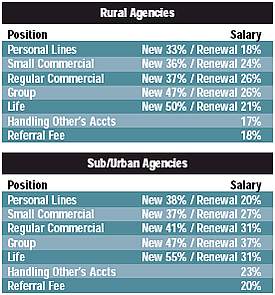
Management/sales compensation
In the case of the compensation for the president, administrative manager, and sales manager, bonuses made up a substantial portion of the total. Most of the time the people filling these positions are also agency owners and it is reasonable to assume that these bonuses, even if “discretionary,” tracked pretty closely with the overall profitability of the agency and represented a large potion of the ownership return on investment. Additionally, in many insurance agencies the people who are managers are also producers. Part of the compensation paid may be for their sales performance rather than strictly for management duties.
In almost every single category, management salaries have increased over the past two or three years, sometimes significantly, and the bonus levels are somewhat higher. It is important to note that the average rural agency in this study has only one-third the revenues of the average urban agency, so agency size as well as location enters into the difference in management salary and bonus levels between the two groups.
More than 80 percent of independent agencies nationwide give both owner and non-owner managers a bonus, with most of them paying on a discretionary basis. Of those firms that use some kind of tangible criteria for determining the bonus dollars a percentage of agency profits is by far the most common.
Owners’ compensation
It is difficult to get a handle on the methods for computing compensation paid to agency principals because these people are usually both owners and key sales and management personnel. The vast majority still uses some combination of performance measurement and ownership percentage to come up with salaries and bonuses. The two major factors cited in determining salaries are the size of the existing book being handled and the ownership percentage in urban agencies. Rural agencies look first at the ownership percentage and then take into account management duties.
Regardless of location the primary criteria for determining bonuses were percentage of ownership followed by the size of the book handled or management contribution. For both salaries and bonuses each of the groups indicated that longevity is no longer a major component for determining an agency principal’s compensation. When a commission percentage is used to determine the owner’s salary, 50 percent of the rural firms use the same rate as is used for non-owner producers and 70 percent of the urban agencies use the same percentage. The number of rural agencies with perpetuation plans was 66 percent, slightly less than the 68 percent reported in 2000. Suburban/urban agencies managed to increase their percentage to 72 percent versus the 68 percent in 2000.
Patrice Nolan is managing director, Middleton Services, with Marsh, Berry & Company Inc. She can be reached via e-mail at patrice@ marshberry.com. The Middleton Letter is a Marsh, Berry & Company Inc. publication in memory of Carol Hammes. Subcriptions to The Middleton Letter as well as MarshBerry. com, an online agency management resource, are available at www.marshberry.com.
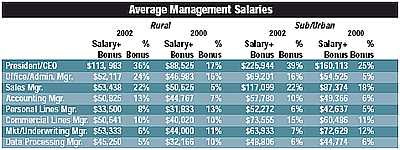


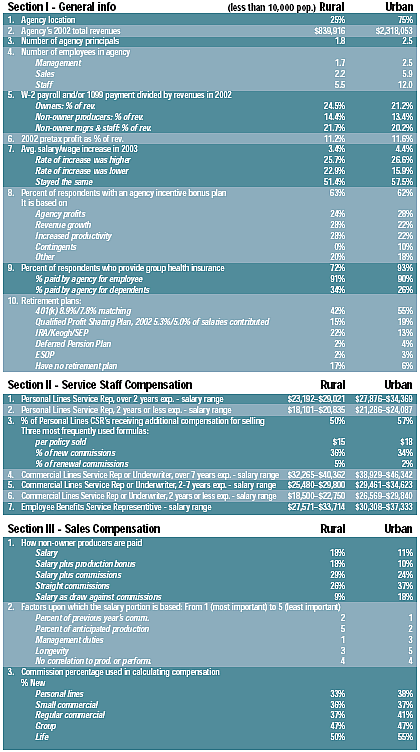
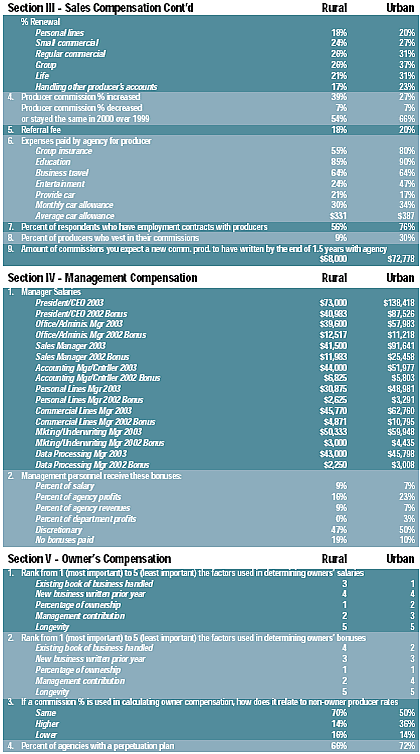
Topics Trends Agencies Profit Loss Talent
Was this article valuable?
Here are more articles you may enjoy.


 Insurance Industry ‘Megadeals’ Dominate 2025, Says PwC
Insurance Industry ‘Megadeals’ Dominate 2025, Says PwC  Aon Adds to List of Brokers Suing Howden US for Alleged Poaching, Theft
Aon Adds to List of Brokers Suing Howden US for Alleged Poaching, Theft  Three Top P/C Insurers Account for Most of Insurance AI Patents
Three Top P/C Insurers Account for Most of Insurance AI Patents  North Carolina Sting Operation Alleges Roofer Damaged Shingles to File Claim
North Carolina Sting Operation Alleges Roofer Damaged Shingles to File Claim 


